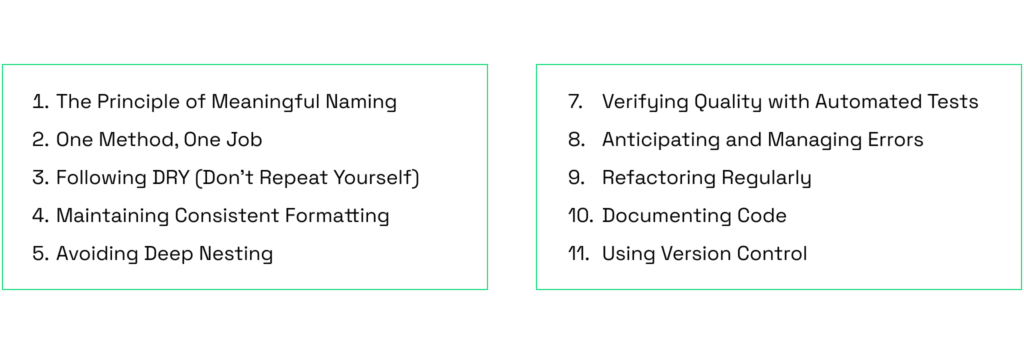Code quality can make or break your app’s architecture, and maintaining it is one of the toughest tasks.
When a Ruby on Rails application is launched, everything feels fast and responsive at first. But as features are added, data and user load grow, and the codebase evolves, the true quality of the code starts to show.
And if there’s a mess in the codebase, it’s only a matter of time before things start to slow down, bugs appear more frequently, and developers spend more time untangling old logic than building new features.
In this blog post, let’s explore why building a robust codebase from day one is essential, walk through 10 Rails best practices for writing high-quality code, and discuss what to do if your existing app’s codebase is less than ideal.
Contents:
- Why Clean Rails Code Is the Advantage Most Project Owners Overlook
- 10 Ruby on Rails Coding Standards That Set Good Developers Apart
- What to Do If You’re Unsure About Your App’s Code
- Final Thoughts
Why Clean Rails Code Is the Advantage Most Project Owners Overlook
When you’re starting a new RoR project, your main goal is usually to get it to market quickly. In the rush to build and release, small inconsistencies in the code are often missed, with the intention of fixing them later. But over time, those “fix it later” moments can start to cause real problems such as:
- More frequent bugs. Quick fixes and inconsistent logic lead to unexpected errors and unstable behavior.
- Increased technical debt. The longer issues are postponed, the more time and money it takes to fix them later.
- Slower development. As the codebase grows messier, adding new features takes longer and becomes riskier.
- Harder onboarding. New developers struggle to understand the code, which delays their ability to contribute.
- Scalability challenges. Code that isn’t built with maintainability in mind can hold your product back as it grows.
Here’s a real-world example.
Our client, Donor Sibling Registry, a platform that connects donor-conceived individuals with their biological relatives, came to us with a messy codebase after switching from PHP/MySQL to Ruby on Rails/PostgreSQL. After their previous developers left, the website began to suffer from frequent bugs, slow load times, and unexpected crashes. On top of that, during our UI/UX design audit, we uncovered significant usability issues. Both the code and the user experience required serious attention.
Our Ruby on Rails developers performed a comprehensive code audit, outlined a clear improvement plan, and implemented the fixes. At the same time, our UI/UX team redesigned the interface, leading to a significant boost in usability.
Writing clean, maintainable Rails code from the start is important. When your code is readable and well-structured, your product can grow smoothly, future costs stay lower, and your team gains the confidence to build and scale without the fear of breaking things.
Let’s take a look at the key reasons why clean Rails code matters so much.

Faster & safer updates
Imagine trying to update a recipe that’s handwritten in messy shorthand with half the ingredients missing. You’d waste time just figuring out what’s going on before you even start cooking. That’s what messy code feels like to developers.
When your RoR code is clean, developers can jump in, understand what’s happening, and make changes without worrying they’ll accidentally break something else.
Your app is more reliable
When code is consistent, it’s easier to spot edge cases, test properly, and avoid weird behavior in your app. It means fewer crashes, fewer “Why is this not working?” moments, and a smoother experience for your users.
You cut future development expenses
Readable Ruby code reduces the cost of future updates, new features, and bug fixes. You won’t need to rebuild entire parts of your system just to change a button or add a new feature.
Code scales better as your business grows
What works for 100 users might break for 10,000. Well-structured code is usually better tested and easier to optimize. So as your app grows, you won’t be constantly patching things to keep it from falling apart.
Spot performance issues faster
Clean Rails code makes it obvious where things are working well and where there’s a bottleneck. That helps your team find slow parts of the app and make them faster without breaking other things.
You can plan more confidently
If your code is a mess, every new feature is a gamble. Will it take a day or two weeks? With organized code, developers can give more accurate estimates, which means better planning, fewer surprises, and happier teams and clients.
Healthier workflows
Even if you don’t touch the code yourself, you’ll feel the difference. Well-structured and readable code means fewer delays, better communication with your dev team, and more trust.
A clean and maintainable codebase ensures long-term sustainability, scalability, and cost-efficiency, which is far beyond just aesthetics or developer preferences.
At Rubyroid Labs, we’ve been prioritizing clean and maintainable Rails code for over 12 years to ensure applications are robust and built to last.
Our RoR developers provide Rails development services across a wide range of industries, including automotive, e-commerce, e-learning, healthcare, real estate, sports & fitness, drones, insurance, fintech, and more.
If you’re unsure about the quality of your existing codebase, you can book a call with one of our team leads to explore how we can help solve the problem.

10 Ruby on Rails Coding Standards That Set Good Developers Apart
Choosing the right RoR developer for a new project can feel like solving a puzzle on hard mode. While Ruby on Rails is known for its developer-friendly syntax and conventions, there’s always a risk of hiring someone whose skills don’t meet the demands of a production-level project.
As a Rails development company with over 300 successful applications under our belt, we’d like to share our 10 best practices for writing robust, maintainable code.
By learning these Ruby on Rails coding standards, you’ll be able to spot great developers, recognize clean, scalable code, and assess the quality of work on your project.

1. The Principle of Meaningful Naming
Before you even read a line of logic, the names of variables, methods, and classes should tell a story. Using clear, descriptive names makes the code instantly more readable and understandable.
A variable is a placeholder for data, a method (or function) is a block of code that performs a task, and a class is a blueprint for creating objects.
Clear naming reduces mental gymnastics. When a Rails developer can quickly understand what a piece of code does, they can work on it faster and with fewer mistakes.

Ruby Example
# Not so good
d = user.days_since_creation
# Much better!
days_since_last_login = user.days_since_last_login
2. One Method, One Job, or Single Responsibility Principle
Every method should do one thing and do it well. If we find a method of doing too much (e.g., finding a user, checking their permissions, and sending an email), it’s time to break it down.

3. Following DRY (Don’t Repeat Yourself)
Seeing the same chunk of code in multiple places is a major red flag. The DRY principle is about avoiding that code duplication by abstracting repeated logic into a reusable place.

Ruby Example
# Repetitive code in a view
<p>User created on: <%= user.created_at.strftime("%B %d, %Y") %></p>
<p>Post published on: <%= post.created_at.strftime("%B %d, %Y") %></p>
# DRY version using a helper
# In app/helpers/application_helper.rb
def formatted_date(date)
date.strftime("%B %d, %Y")
end
# In the view
<p>User created on: <%= formatted_date(user.created_at) %></p>
<p>Post published on: <%= formatted_date(post.created_at) %></p>
4. Maintaining Consistent Formatting
A codebase should have a single, consistent style for things like indentation, spacing, and line breaks. It’s like ensuring every page in a book has the same font and margins, it just makes it easier to read.

5. Avoiding Deep Nesting
Deeply nested “if” statements or loops create what’s often called “arrow code” (because it visually pushes your code to the right). This can be very difficult to read and follow.
On the contrary, flatter code is clearer code. By reducing nesting, often with techniques like “guard clauses,” you make the logic flow easier to understand at a glance.

Ruby Example
# bad
def compute_thing(thing)
if thing[:foo]
update_with_bar(thing[:foo])
if thing[:foo][:bar]
partial_compute(thing)
else
re_compute(thing)
end
end
end
# good
def compute_thing(thing)
return unless thing[:foo]
update_with_bar(thing[:foo])
return re_compute(thing) unless thing[:foo][:bar]
partial_compute(thing)
end6. Verifying Quality with Automated Tests
Tests are small, automated checks that verify a specific piece of code (a “unit”) works as expected. They are a developer’s safety net.
A unit test confirms that an individual method or class behaves correctly in isolation.
Testing gives you the confidence to make changes and add new features without accidentally breaking existing functionality. It also significantly simplifies the process of upgrading Ruby or Rails versions, as without tests, everything would have to be checked manually.

7. Anticipating and Managing Errors
Sometimes things go wrong, like an external service might be down, or a user might input bad data. A robust application anticipates these potential failures and handles them gracefully instead of crashing.
Proper error handling leads to a much better user experience and prevents data corruption. It shows users a helpful message instead of a generic error page, maintaining their trust in your application.

8. Refactoring Regularly
Refactoring is the process of restructuring and improving existing code without changing its external behavior. It’s like tidying up a workshop after a big project to keep it efficient for the next one.

9. Documenting Code
Modern best practice isn’t about commenting on every line. Good, clean code with meaningful names is often self-documenting. Comments should be reserved for explaining the why, not the what, for instance, why a complex business rule is implemented in a particular way.

10. Using Version Control
Version control, most commonly with a system called Git, is like having a complete history of every change ever made to the project. It allows developers to track changes, collaborate, and safely roll back to a previous version if something goes wrong.

Following these practices helps maintain a professional mindset focused on building long-term value. Clean, well-structured code leads to more robust applications, happier project owners and development teams, and ultimately, more successful outcomes. It’s the foundation upon which great digital experiences are built and sustained.
What to Do If You’re Concerned About Your App’s Code
For a project owner without a technical background, it can be difficult to understand whether the app’s codebase is in good shape. Issues in the code often stay hidden until you bring in a development team to conduct further upgrades or bug fixes.
On the surface, everything works fine, but under the hood, the code is fragile, outdated, or poorly structured. In these cases, a fresh set of experienced eyes can make all the difference.
That’s where code review and code refactoring come in. These services help ensure your app is reliable, maintainable, and ready for growth.

Code Review
A code review is a detailed health check for your application. Programmers go through your existing codebase, line by line, and assess its structure, quality, and potential risks.
It’s like a home inspection before buying a house, where you may not see the cracks in the foundation, but an expert will. Developers identify parts of your code that are difficult to maintain, overly complex, or potentially causing performance issues.
- Areas of concern.
- Security risks (if any).
- Opportunities for improvement.
- Recommendations for next steps.
This service is ideal if you’re planning future development and want to avoid surprises.
Code Refactoring
If a code review reveals significant issues or if your app has become hard to maintain, then code refactoring might be the next step.
Refactoring means improving the internal structure of your code without changing how the app works for users.
By cleaning up the code, it’s easier to
- Fix bugs faster.
- Add new features without breaking things.
- Reduce technical debt.
- Improve performance and stability.
So, refactoring is an investment in your app’s long-term health. It pays off by making future development smoother and more cost-effective.
If you’re unsure about the state of your app’s code, don’t worry, you’re not alone. Many successful projects start with a little cleanup. A code review or refactoring plan can give you clarity, reduce risk, and help you move forward confidently.
Final Thoughts
Writing quality code is a serious responsibility. After all, no one wants to get tangled up in the consequences of a weak and messy codebase, like mounting technical debt, frequent bugs, or frustrating scalability issues.
That’s exactly why choosing the right partner to develop your application is so critical. An experienced Ruby on Rails developer follows a proven set of best practices that help ensure an application remains stable, efficient, and easy to maintain. While every project is unique, the core principles of quality engineering remain the same.
However, not all applications are launched with clean, well-structured code. A messy codebase can result from a number of factors:
- Developers with limited experience or poor coding habits
- A rushed transition from one framework or tech stack to another
- Lack of clear coding standards or documentation
- Tight deadlines that prioritized speed over quality
- Frequent changes in the development team
- Minimal or no code reviews during development
Good news! It’s not the end of the world. With the help of a skilled development team and a thoughtful code review, even a poorly structured codebase can be refactored and brought back on track.
If you’re currently facing issues with your codebase or even just have doubts about its structure, we can help. Our team can conduct a comprehensive code audit, identify critical problem areas, and provide a clear, actionable roadmap for improvement.
Let’s make sure your code is working for your business, not against it.




